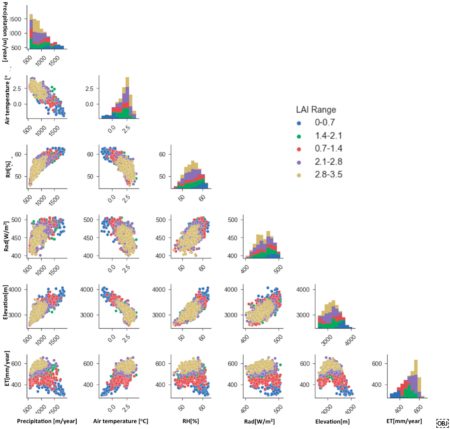
Pairwise scatter plots of meteorological forcing variables, elevation and annual evapotranspiration (ET). Different colors represent ranges of leaf area index (LAI) values. Bar plots shows the variation of meteorological forcing variables, elevation and annual ET
An important process for determining the water and energy balance at the land surface is evapotranspiration. This is one of the first studies that comprehensively investigated the spatio-temporal variations of evapotranspiration in a mountainous watershed. The results showed that the spatial variability in evapotranspiration was closely corrected with the land elevation, air temperature, and vegetation, and that evapotranspiration in areas with more finely textured soil was slightly larger than regions with coarse-textured soil.
This study presents a promising approach for assessing evapotranspiration with a high spatio-temporal resolution over watershed scales and it investigates the factors controlling spatio-temporal variations in evapotranspiration.
Summary
Evapotranspiration (ET) is a key component of the water balance in a given component of the Earth system, and it influences hydrometeorology, water resources, carbon and other biogeochemical cycles, as well as ecosystem diversity. This study sought to investigate the spatio-temporal variations of ET at the East River watershed in Colorado and analyze the factors that control these variations. The simulation results showed that 55% of annual precipitation in the East River is lost to ET, in which 75% of the ET comes from the summer months (May to September). The authors also found that the contribution of transpiration to the total ET was ~50%, which is much larger than that of soil evaporation (32%) and canopy evaporation (18%). Spatial analysis indicated that the ET is greater at elevations of 2950–3200 m and lower along the river valley (3900 m). A correlation analysis of factors affecting ET showed that the land elevation, air temperature, and vegetation are closely correlated and together they govern the ET spatial variability. The results also suggested that ET in areas with more finely textured soil is slightly larger than regions with coarse-texture soil.
Citation
Tran, A.P.; Rungee, J.; Faybishenko, B.; Dafflon, B.; Hubbard, S.S. Assessment of Spatiotemporal Variability of Evapotranspiration and Its Governing Factors in a Mountainous Watershed. Water 2019, 11, 243. DOI: 10.3390/w11020243
